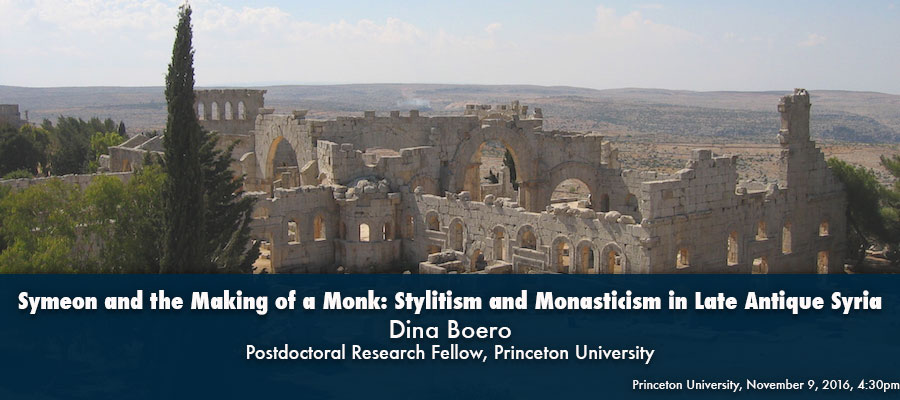Symeon and the Making of a Monk: Stylitism and Monasticism in Late Antique Syria, lecture by Dina Boero (Postdoctoral Research Fellow, Princeton University), Princeton University, November 9, 2016, 4:30pm
Prior to the Council of Chalcedon (451 CE), diversity characterized asceticism in late antique Syria. Canon four of the council put monasteries and individual monks under ecclesiastical jurisdiction. Consequently, post-Chalcedonian bishops and monks relegated independent ascetics to monasteries overseen by bishops. The power of individual ascetics decreased while coenobitic monasteries and their leaders successfully laid claim to spiritual authority (Vööbus 1958-1988, Escolan 1999, Caner 2002, Booth 2014). The career and cult following of Symeon the Stylite the Elder (c. 390–459 CE) was, in many ways, emblematic of this change. Famous for standing on a column in rural northern Syria for forty years, Symeon was one of the most prominent independent ascetics of Late Antiquity. Despite his renown, Symeon was chastised by coenobitic monks throughout his ascetic career. However, in the fifty years following his death, Symeon became a model for monks and his column-standing an encouraged option within monastic communities. This presentation highlights three critical pieces of evidence for this shift: the establishment of a coenobitic monastery at Symeon’s cult site (c. 490), Jacob of Serugh’s (d. 521) writings on Symeon, and the incorporation of stylite columns into coenobitic monasteries. Previous scholars have studied these sources independently. Consequently, they have overlooked this transformation in institutional support for Symeon’s cult. This presentation clarifies this transformation and aligns it with broader historical changes taking place within Syrian monasticism. It shows how coenobitic monasteries incorporated stylitism into their communal structures while also shedding light on the consolidation of monasticism following the Council of Chalcedon.
Respondent: Jack Tannous,Department of History, Princeton University
Dina Boero holds a BA in Religion from the University of California: San Diego and a MA and PhD in Classics from the University of Southern California. Her research focuses saints and their cults in the late antique Near East, integrating literary, codicological, and archaeological sources. Her current book project, The Anatomy of a Cult, traces the history of Symeon the Stylite the Elder’s (d. 459) cult in the fifth and sixth centuries. In fall of 2017, she will take up the post of Assistant Professor of History at The College of New Jersey.
